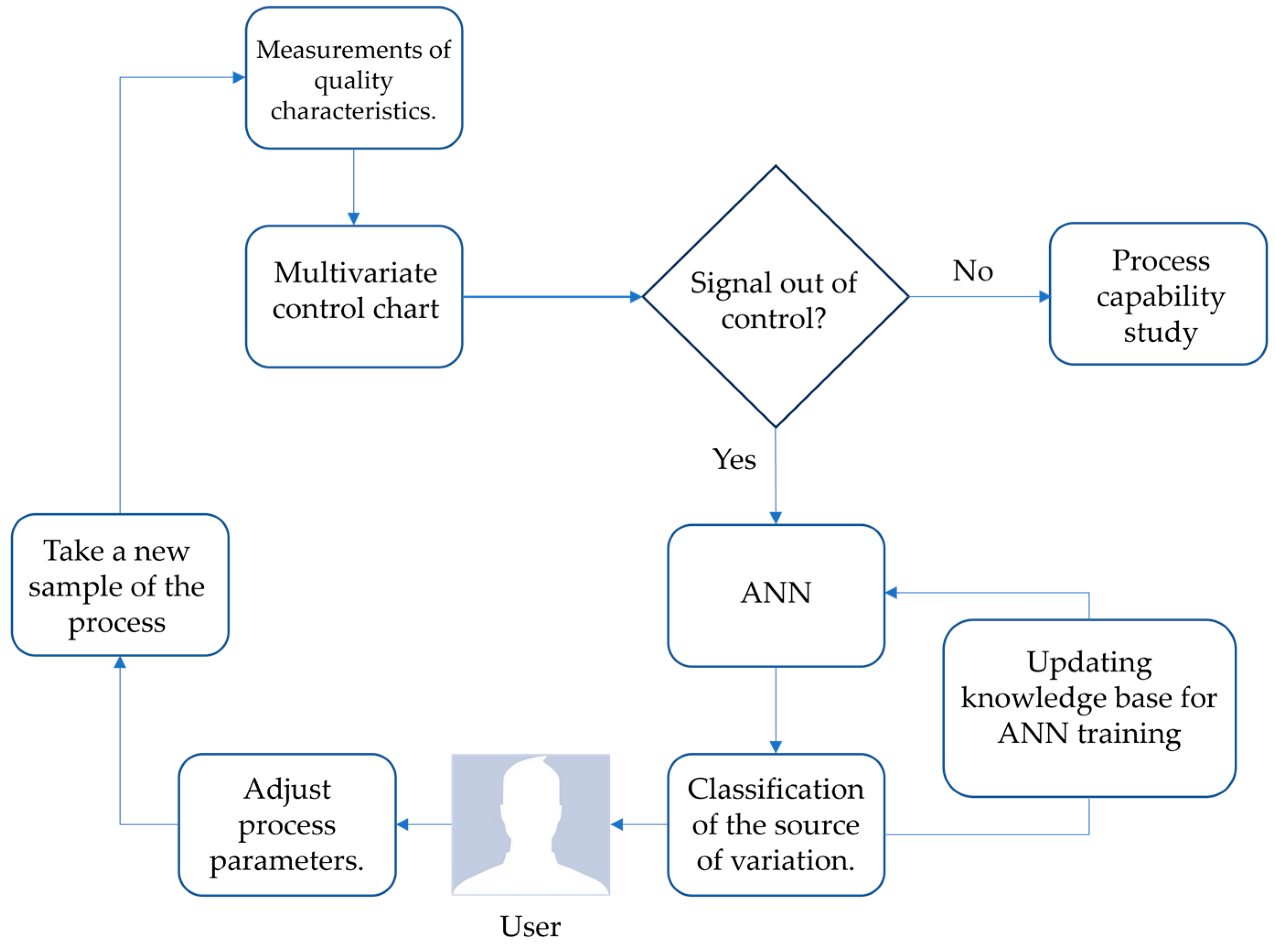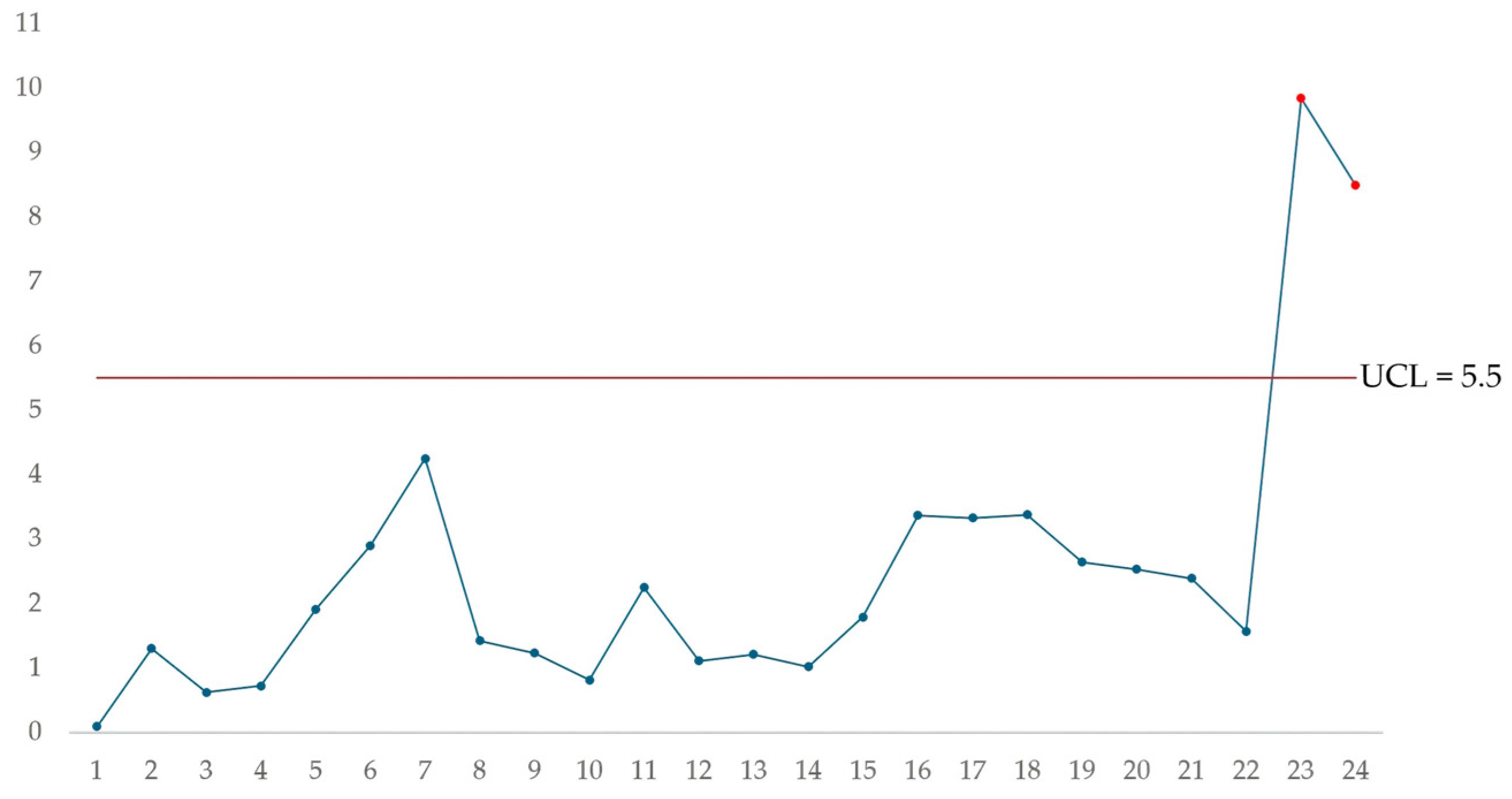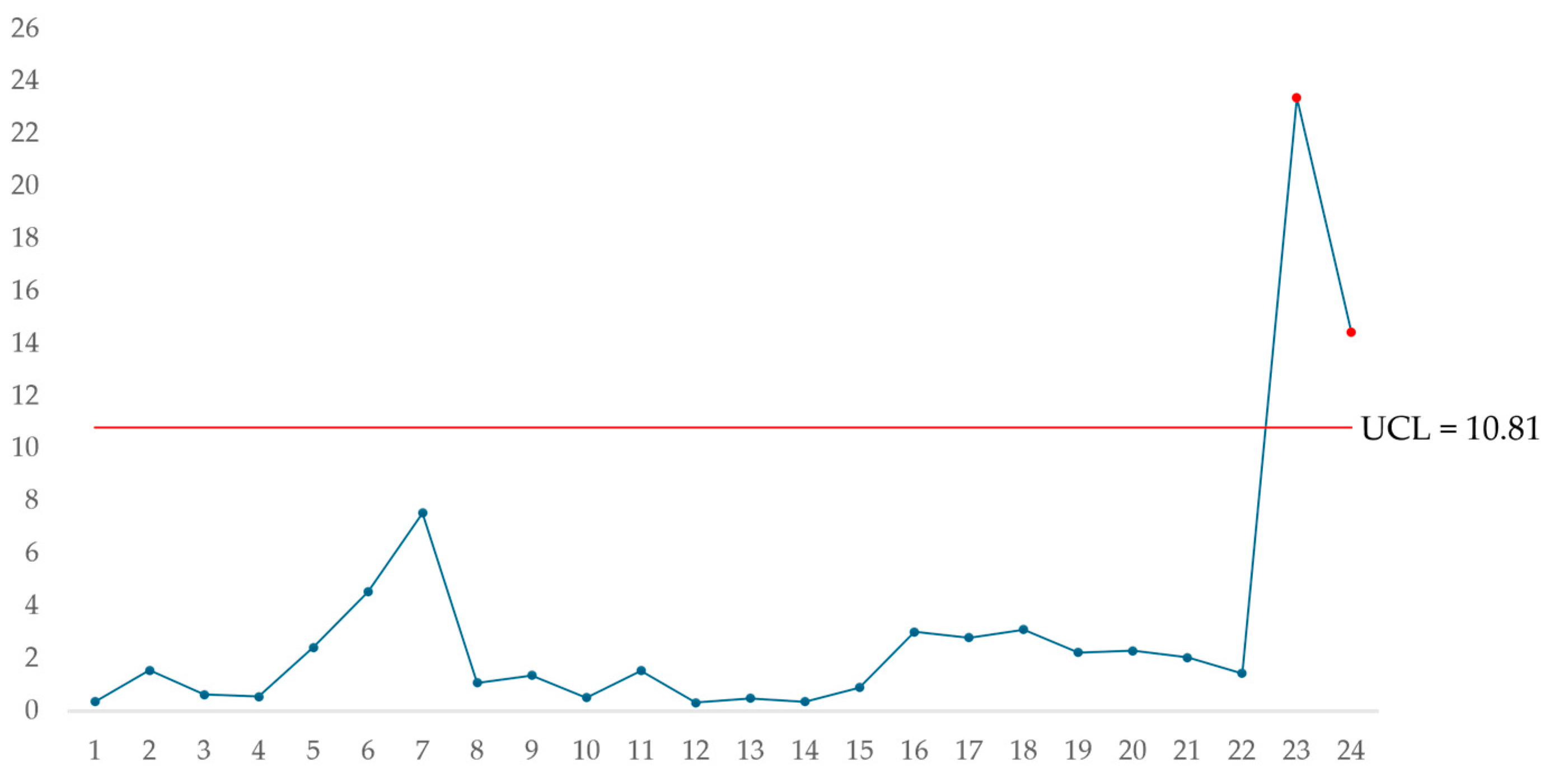This section consists of the development of the different materials used for the construction of the proposed methodology; the methods contemplate the detailed description of the approach and execution of the multivariate control charts, artificial neural network multilayer perceptron, and support vector machine.
3.1. Development of Multivariate Control Charts
To exemplify the construction of the multivariate control charts MCUSUM and MEWMA, 30 observations are shown for each of the variables from data taken from production, which will allow estimating the vector of means and covariance matrix. See
Table 3.
The vector of means and covariance matrix are defined in Equations (11) and (12), respectively.
To verify the multivariate normality assumption, the Mardia test is applied. According to the results, the sample follows a multivariate normal distribution with a significance level of 0.05, skewness of
(0.0774) >
(0.05), and kurtosis of
(0.8341) >
(0.05). See
Table 4.
To continue with the development of the multivariate control chart, a new sample of measurements is extracted for each of the quality characteristics monitored in the process, which will allow verifying the statistical stability of the manufacturing system, in this case, the supervision in the application of solder in the assembly process of the electronic cards.
Table 5 shows the sample that will be used to exemplify the development of the MCUSUM and MEWMA control chart.
The detailed procedure for calculating the MCUSUM control chart statistics is shown. We take, as an example observation number, one of the samples and start with the difference between the sample and the vector of means; see Equation (13).
Substitute in Equation (6) to obtain the
value of Equation (14) and evaluate the case in Equation (5).
Equation (15) is solved, obtaining Equation (16).
Finally, the multivariate MCUSUM statistic is calculated by substituting in Equation (4) and the statistic for observation number is obtained; see Equation (17).
Table 6 shows the MCUSUM statistics for each of the observations used to construct the control chart; the procedure is the same as shown above for each observation.
Figure 3 shows the MCUSUM control chart resulting from plotting the statistics and the control limit. The MCUSUM chart shows that samples twenty-three and twenty-four generate an out-of-control signal in the welding application process; these samples should be analyzed to identify the nature of the variation and correct the statistical lack of control of the process.
The structuring of the MEWMA control chart begins by defining the depth value for the chart memory; for this case, a value of (λ = 0.1) was taken. The estimation of the statistic starts with the substitution of the initial data in Equation (7), and the solution is shown in Equation (18)
The MEWMA statistic for the first measurement is obtained by solving Equation (19).
The control limit was defined according to the value of p = 3, λ = 0.1, and an average run length (ARL) of ARL = 200; therefore, the control limit is equal to (10.81).
Table 7 presents the MEWMA plotted statistics.
Figure 4 shows the MEWMA control chart after plotting the statistics and the control limit.
For the solder application process on the PCB boards, both multivariate control charts detected out-of-control signals, and now the person responsible for the process must correct the problem in the production system that causes the variation, which implies time, resources and a complementary analysis. Next, the development of the proposed system based on the multilayer perceptron artificial neural network to detect which of the analyzed variable(s) is (are) out of control automatically is discussed.
3.2. Development of the Artificial Neural Network Multilayer Perceptron
As mentioned above, the operation of the artificial neural network multilayer perceptron consists of two significant tasks: training and testing. The data set generated for the training phase is integrated by simulating one hundred events with variation in the vector of means for each of the seven possible categories with levels of 0.5σ, 1.5σ, and 2.5σ, building a training matrix of size [3 × 2100].
Table 8 shows how to set up the training with a variation of 0.5σ in the vector of means for the seven possible categories of the industrial application case under study. The objective values required by the artificial neural network to perform the task of classification and recognition of the dissimilar categories are assigned according to the hyperbolic tangent activation function, which can take continuous values in the range [−1, 1] and are assigned equidistantly in the domain of the function.
The test matrix is developed from simulated data from measurements obtained from the manufacturing system; the data are classified in two hundred vectors that present different magnitudes of variation in each of the variables, and the magnitude of variation contemplated is 1σ, 2σ, and 3σ. Since there are seven possible categories in the response variable, a matrix of [3 × 4200] is generated. Once the training and test sets have been developed, the ANN architecture is built. The efficiency of the proposed method for the analysis of out-of-control signals will depend directly on the accuracy with which the artificial neural network classifies the changes that occurred in the different variables during the manufacturing process. To achieve adequate efficiency, it is necessary to establish correct operating parameters in the ANN; to achieve this objective, an experiment was carried out. The ANN topologies proposed in
Table 9 are architectures that adequately classify the values established during the training phase, so a statistical parameter such as the mean square error (MSE) was used to determine the topology that should be selected for the test phase and subsequently solve the classification task.
Artificial neural network architectures were developed dynamically by constructing an algorithm based on exhaustive experimentation conditioned on cycles to evaluate the total number of possible combinations of topologies. The first parameter considered is the number of neurons in the hidden layer with an interval of [5, 2000]. The second parameter is the learning rate with an increment factor of 0.001 [0.005, 0.9]. The allowed error was set to only two possibilities, 1 × 10−4 and 1 × 10−5. Finally, training was scheduled to pause via the down gradient method if the error function did not improve by at least 0.0001 over one hundred iterations. For each architecture, its output was recorded in a database to proceed to calculate the mean square error against the previously established target values and this was the mechanism for the selection of the topologies. The advantage of the proposed procedure is to ensure a global minimum and avoid falling into local minima.
Table 10 shows the topology of the ANN selected to carry out the classification task of the variable(s) generating variation in the manufacturing system to establish an efficient multivariate statistical process control analysis based on artificial intelligence. Once the weights and biases with which the ANN operates have been obtained, the classification task is automatic, since it only involves matrix operations.
When a signal out of statistical control occurs, it is vital to detect the variable(s) causing the variation in the process to correct the operating conditions early. The multilayer ANN classification scheme is based on synaptic weights and bias generated from the iterative training process, exemplified by observation twenty-three.
W
1: synaptic weights of the first layer (1492 × 3):
b
1: bias of the first layer (1 × 1492):
W
2: synaptic weights of the hidden layer (1 × 1492):
b
2: bias of the hidden layer (1 × 1):
Substituting the values of the measurements that generate the out-of-control signal in the process and the input layer matrices in Equation (9), Equation (20) is obtained, generating as a result a vector with dimensions of [1 × 1492].
For each value obtained from the vector,
is substituted in Equation (10), resulting in a vector [1 × 1492]; see Equation (21).
Finally, the response issued by the methodology is generated by substituting in the general ANN function the matrices of weights
, bias
, and the transpose of the resulting vector of the first layer
see Equation (22).
The variable
corresponds to the value that the ANN assigned to the measurement that caused the out-of-control point in the multivariate control charts,
According to the multilayer ANN perceptron output, sample twenty-three was associated with category number four of the seven possible categories since it is the closest value to the ANN classification. For this reason, the ANN result suggests that the variable volume and area present an excessive variation. As can be seen in
Table 4, the data for the quality characteristics volume (0.09991) and area (0.76860) are not within specification; see
Table 1. Therefore, the ANN correctly analyzed the system variation by identifying the source of variation.
One purpose of the research is to compare the results obtained by the multilayer perceptron ANN, and therefore a support vector machine was developed since it is important to highlight that according to the literature review, both classification approaches have been employed for the analysis of variation in manufacturing systems.
3.3. Development of Support Vector Machine
For the development of the support vector machine, use was made of the same training and test sets used in the multilayer perceptron ANN since it also works under a supervised training approach. It is important to consider that the classification of out-of-control signals in multivariate control charts is of the nonlinear type, so a polynomial kernel function was implemented with the one-versus-one method, since a scenario where there are more than two categories is addressed. For the construction of the SVM, it is vital to consider that the hyperparameter cost (C) controls the balance between bias and variance; it is a concept that allows us to understand the ability of the SVM when faced with data that have not been used in the training phase, i.e., its generalization capacity [
31]. To select an optimal cost value, different values were evaluated by cross-validation [ 0.001, 0.01, 0.1, 1, 1, 5, 10, 15, 20, 25]. The cost value resulting in the lowest validation error is 10 (0.0348); see
Figure 5. The degree of the generated model is the third and the number of support vectors is 203.

















